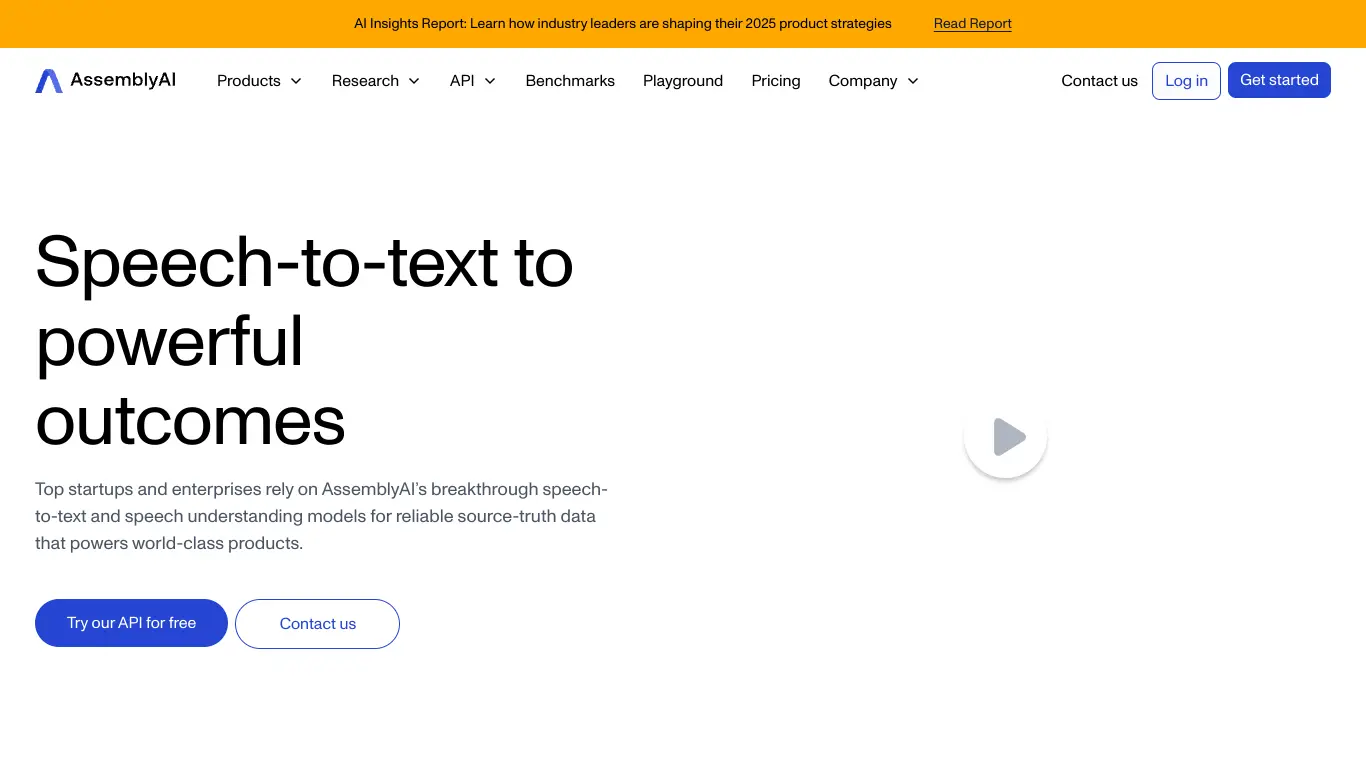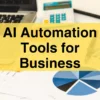AssemblyAI offers highly accurate speech-to-text APIs with audio intelligence features for developers building voice-enabled applications.
Introduction to AssemblyAI
Whether you’re a developer building the next game-changing application, a researcher analyzing hours of interviews, or a business looking to extract insights from customer calls, you need a reliable speech-to-text solution that just works. This is precisely where AssemblyAI enters the picture.
What is AssemblyAI and its Purpose?
AssemblyAI is a powerful, developer-friendly API platform that specializes in speech recognition and audio intelligence. At its core, AssemblyAI transforms spoken language into highly accurate text using advanced deep learning models. But it goes far beyond basic transcription—the platform offers a comprehensive suite of audio intelligence features designed to extract meaningful insights from voice data.
Founded with the mission to make state-of-the-art AI models accessible to developers, AssemblyAI serves as a bridge between cutting-edge speech AI research and practical applications. Their API-first approach means developers can integrate advanced speech recognition capabilities into their applications without having to build complex AI infrastructure from scratch.
The platform’s purpose is threefold:
- To provide accurate, scalable, and efficient speech-to-text conversion
- To offer advanced audio intelligence capabilities that extract meaning from speech
- To make these sophisticated AI tools accessible through simple, developer-friendly APIs
Who is AssemblyAI Designed For?
AssemblyAI caters to a diverse range of users, but its primary audience includes:
🧑💻 Developers and Engineering Teams: Software engineers who need to integrate speech recognition into their applications without building complex AI infrastructure.
🏢 Enterprises: Organizations processing large volumes of voice data, such as call centers, meeting recordings, or customer interactions.
🔬 Researchers: Academic and industry researchers who need to analyze spoken content at scale.
🎥 Content Creators: Media companies and content platforms that need to generate transcripts, captions, or analyze audio content.
🚀 Startups: Early-stage companies building voice-enabled products who need enterprise-grade speech AI without enterprise-level resources.
The platform is particularly valuable for industries like:
- Healthcare (for medical dictation and patient records)
- Legal (for court proceedings and document preparation)
- Media (for content analysis and automatic captioning)
- Customer service (for call analysis and quality assurance)
- Education (for lecture transcription and accessibility)
Getting Started with AssemblyAI: How to Use It
Getting started with AssemblyAI is straightforward, especially for developers familiar with REST APIs. Here’s a simple guide to begin using the platform:
- Sign Up for an Account: Visit AssemblyAI’s website and create a free account to get your API key.
- Choose Your Integration Method: AssemblyAI offers multiple ways to integrate:
- REST API (compatible with any programming language)
- SDK libraries for Python, Node.js, and other languages
- No-code options via Zapier and other platforms
- Basic Implementation: For a simple transcription, you just need to:
- Authenticate with your API key
- Submit an audio file or URL
- Retrieve your transcription results
Here’s a basic example using Python:
import assemblyai as aai
# Replace with your API key
aai.settings.api_key = "your-api-key"
# Create a transcriber
transcriber = aai.Transcriber()
# Transcribe a file
transcript = transcriber.transcribe("https://example.com/audio.mp3")
# Print the transcribed text
print(transcript.text)
- Explore Advanced Features: After mastering basic transcription, you can explore additional features like:
- Real-time transcription for live audio streams
- Audio intelligence (sentiment analysis, entity detection, etc.)
- Custom vocabulary for domain-specific terminology
- Speaker diarization to identify different speakers
The platform’s documentation provides comprehensive guides, code samples, and tutorials to help users implement these features efficiently.
AssemblyAI’s Key Features and Benefits
Core Functionalities of AssemblyAI
AssemblyAI delivers a comprehensive suite of speech AI capabilities through its API. Here’s a breakdown of its core functionalities:
🎯 Speech-to-Text Transcription
The foundation of AssemblyAI is its highly accurate transcription engine that converts spoken words into text. Key aspects include:
- Support for 100+ languages and dialects
- 90%+ accuracy rates across various accents and speech patterns
- Optimized for challenging audio environments with background noise
- Support for both pre-recorded and real-time audio
🔄 Real-Time Transcription
For applications requiring immediate transcription:
- Stream audio directly to the API
- Receive transcription results with minimal latency
- Ideal for live captioning, meeting transcription, and interactive applications
👥 Speaker Diarization
This feature identifies and labels different speakers in a conversation:
- Automatically distinguishes between speakers
- Labels each segment of text with speaker identification
- Crucial for meeting transcription and multi-speaker content
📊 Audio Intelligence
Going beyond simple transcription:
- Sentiment Analysis: Detects positive, negative, or neutral sentiment in speech
- Entity Detection: Identifies and categorizes named entities like people, places, organizations
- Content Moderation: Flags inappropriate or sensitive content
- Topic Detection: Identifies main topics discussed in audio
- Auto Chapters: Automatically segments content into meaningful chapters
🎯 Custom Language Models
For specialized terminology and domains:
- Train models on industry-specific vocabulary
- Improve accuracy for technical, medical, legal, or other specialized content
- Fine-tune for specific accents or speaking styles
Advantages of Using AssemblyAI
⚡ Developer-First Approach
AssemblyAI is built with developers in mind:
- Clean, well-documented APIs
- SDKs for popular programming languages
- Extensive examples and implementation guides
- Responsive developer support
🔒 Enterprise-Grade Security
For organizations with strict security requirements:
- SOC 2 Type II compliant
- HIPAA compliance available
- Data encryption in transit and at rest
- Flexible data retention policies
📈 Scalability
Designed to handle varying workloads:
- Process thousands of audio hours concurrently
- Automatic scaling during usage spikes
- No infrastructure management required
- Pay-as-you-go pricing model
🚀 Continuous Improvement
AssemblyAI’s models keep getting better:
- Regular model updates improve accuracy
- New features added based on user feedback
- Backwards compatibility maintained during upgrades
- Access to cutting-edge AI research implementations
🔍 Detailed Analytics
Get insights beyond the text:
- Word-level timestamps for precise audio alignment
- Confidence scores for each transcribed word
- Detailed metadata about audio processing
- Performance analytics for API usage
Main Use Cases and Applications
AssemblyAI’s versatile platform enables a wide range of applications across industries:
📞 Call Center Analytics
- Transcribe customer service calls for quality assurance
- Identify customer sentiment and satisfaction trends
- Extract key topics and issues from support calls
- Automate compliance monitoring
📝 Meeting Intelligence
- Create searchable transcripts of meetings and conferences
- Generate automated meeting minutes and action items
- Analyze speaking patterns and participation rates
- Enable accessibility for team members
🎬 Media Production
- Generate captions and subtitles for videos
- Create searchable archives of audio/video content
- Extract clips based on spoken content
- Enable content moderation at scale
🏥 Healthcare Documentation
- Transcribe patient-doctor conversations
- Document medical procedures and findings
- Extract medical terminology and information
- Support clinical documentation improvement
📱 Voice-Enabled Applications
- Build voice assistants and chatbots
- Create voice-controlled interfaces
- Enable voice search functionality
- Develop accessibility tools for hearing-impaired users
🎓 Educational Tools
- Transcribe lectures and educational content
- Create searchable knowledge bases from spoken content
- Generate study materials from audio sources
- Support language learning applications
🔍 Research and Analytics
- Analyze interview data for qualitative research
- Extract insights from focus groups
- Process audio data for linguistic research
- Support content analysis for market research
Exploring AssemblyAI’s Platform and Interface
User Interface and User Experience
AssemblyAI’s platform is designed with a balance of simplicity and power, making it accessible for both novice developers and experienced engineering teams.
Dashboard Overview
When you log into AssemblyAI, you’re greeted with a clean, intuitive dashboard that provides:
- API key management
- Usage metrics and statistics
- Recent transcription jobs and their status
- Quick access to documentation and support
The web interface follows modern design principles with a minimalist approach that focuses on functionality. Key elements include:
API Playground
One of the most valuable features for developers is the API Playground, which allows you to:
- Test API calls directly in the browser
- Experiment with different parameters and settings
- See real-time responses without writing code
- Generate code snippets in multiple languages
Results Viewer
For those who want to review transcriptions directly in the platform:
- Interactive transcript viewer with timestamps
- Speaker labels visualized with different colors
- Option to download results in various formats (JSON, TXT, SRT)
- Audio playback synchronized with transcript text
Account Management
The platform makes it easy to manage your account with:
- Transparent usage tracking
- Billing management and history
- Team member access controls (for business plans)
- API key rotation and security settings
Platform Accessibility
AssemblyAI emphasizes accessibility in multiple dimensions:
Technical Accessibility
The platform caters to various technical skill levels:
- For Developers: Comprehensive REST APIs, client libraries, and code examples
- For Technical Teams: Integration guides for common platforms and frameworks
- For Non-Technical Users: No-code options via integrations with platforms like Zapier
Cross-Platform Support
AssemblyAI works across different environments:
- Cloud-based processing accessible from anywhere
- Support for all major operating systems
- Mobile-responsive dashboard for on-the-go management
- API access from any device with internet connectivity
Documentation Quality
The platform’s documentation is a standout feature:
- Comprehensive API reference
- Step-by-step tutorials for common use cases
- Interactive code examples
- Clear explanations of complex features
Support Channels
Users can access help through multiple channels:
- Email support (all plans)
- Priority support for business customers
- Active community forums
- Regular webinars and educational content
AssemblyAI Pricing and Plans
Subscription Options
AssemblyAI offers a tiered pricing structure designed to accommodate everyone from individual developers to large enterprises. Here’s a breakdown of their main plans:
Free Tier
For developers who are testing or building small projects:
- 5 hours of audio processing per month
- Access to core transcription features
- Standard model accuracy
- Community support
Pay-as-You-Go
Perfect for projects with variable usage:
- $0.00025 per second of audio (approximately $0.90 per hour)
- No minimum commitment
- Access to all core features
- Standard support
Custom Enterprise Plans
For organizations with high volume or specific requirements:
- Volume discounts for large-scale usage
- Custom model training options
- Dedicated support channels
- Service Level Agreements (SLAs)
- Compliance certifications (HIPAA, etc.)
Additional Feature Pricing
Some advanced features have separate pricing:
- Real-time transcription: Additional $0.000125 per second
- Audio intelligence (sentiment, topics, etc.): Additional $0.00025 per second
- Custom vocabulary: Starting at $500 for model training
Free vs. Paid Features
Understanding what’s included in each tier helps users choose the right plan for their needs:
| Feature | Free Tier | Pay-as-You-Go | Enterprise |
|---|---|---|---|
| Audio Processing | 5 hours/month | Unlimited (pay per use) | Unlimited with volume discounts |
| Core Transcription | ✅ | ✅ | ✅ |
| Speaker Diarization | ✅ | ✅ | ✅ |
| Word-Level Timestamps | ✅ | ✅ | ✅ |
| Real-Time Transcription | ❌ | ✅ (additional cost) | ✅ (included) |
| Audio Intelligence | ❌ | ✅ (additional cost) | ✅ (included) |
| Custom Vocabulary | ❌ | ✅ (additional cost) | ✅ (included) |
| Languages | English only | 100+ languages | 100+ languages + custom |
| Support | Community only | Email support | Dedicated support manager |
| SLA | ❌ | ❌ | ✅ |
| HIPAA Compliance | ❌ | ❌ | ✅ |
Value Considerations
When evaluating AssemblyAI’s pricing against alternatives, consider these factors:
- The accuracy level is often higher than competitors, reducing post-editing costs
- The developer experience and integration simplicity can save engineering time
- Advanced features are accessible without building custom ML infrastructure
- The pay-as-you-go model eliminates waste from unused subscription allotments
AssemblyAI Reviews and User Feedback
Pros and Cons of AssemblyAI
Based on user reviews and industry analysis, here’s a balanced view of AssemblyAI’s strengths and limitations:
Pros 👍
1. Exceptional Accuracy
- Users consistently praise the transcription accuracy, especially for English content
- Performance in noisy environments exceeds many competitors
- Regular model improvements keep increasing accuracy rates
2. Developer Experience
- Well-documented APIs with clear examples
- Consistent and reliable performance
- Thoughtful error handling and debugging support
- Responsive support team for technical questions
3. Feature Richness
- The comprehensive suite of audio intelligence features
- Powerful speaker diarization capabilities
- Flexible customization options for specific use cases
- Continuous addition of new capabilities
4. Scalability
- Handles massive audio processing jobs efficiently
- Consistent performance during usage spikes
- No infrastructure management overhead
5. Integration Simplicity
- Quick implementation time compared to alternatives
- Variety of SDKs and client libraries
- Good backward compatibility when APIs evolve
Cons 👎
1. Pricing for Scale
- Can become expensive for very high-volume applications
- Some competitors offer better pricing for basic transcription
- Additional costs for advanced features add up
2. Processing Time
- Non-real-time transcriptions can take longer than some competitors
- Processing queue times fluctuate during high-demand periods
3. Language Support Depth
- While supporting 100+ languages, accuracy varies significantly
- Non-English languages sometimes lag in feature support
- Custom vocabulary works best for English
4. Learning Curve for Advanced Features
- Full utilization of all capabilities requires technical expertise
- Some advanced features have complex implementation requirements
5. Dashboard Limitations
- Some users report wanting more management features in the web interface
- Batch operations could be more streamlined
- Limited analytics for enterprise usage patterns
User Testimonials and Opinions
Here’s what real users are saying about AssemblyAI:
“We evaluated six different speech-to-text APIs before settling on AssemblyAI. Their accuracy was noticeably better, especially for technical content, and the developer experience is top-notch.”
— Technical Director at a SaaS company
“AssemblyAI has transformed our podcast production workflow. We used to spend hours editing transcripts, but their API gets it right the first time. The speaker diarization is particularly impressive.”
— Independent podcast producer
“The real-time transcription has been a game-changer for our accessibility efforts. We’re now able to provide live captions for all company meetings with minimal latency.”
— Accessibility Manager at a Fortune 500 company
“We love the audio intelligence features. Being able to automatically detect sentiment and key topics from our customer service calls has given us insights we never had before.”
— VP of Customer Experience
“The pricing can add up quickly once you start using the advanced features across large volumes of audio, but the time savings and accuracy make it worth it for our use case.”
— CTO of a media analysis startup
Industry analysts also recognize AssemblyAI’s contributions, with the platform receiving praise for its innovation in specialized speech recognition technologies and its developer-first approach to complex AI implementation.
AssemblyAI Company and Background Information
About the Company Behind AssemblyAI
AssemblyAI was founded in 2017 by Dylan Fox, who previously worked on speech recognition systems at companies like Cisco. The company was born out of a recognition that while speech AI technology was advancing rapidly in research labs, developers lacked easy access to these capabilities through simple, reliable APIs.
Company Mission and Vision
AssemblyAI’s stated mission is to make state-of-the-art AI models accessible to developers everywhere. Their vision centers on democratizing access to advanced speech AI technology, enabling organizations of all sizes to leverage voice data in ways previously only possible for tech giants with massive AI research budgets.
Growth and Funding
The company has experienced significant growth since its founding:
- Raised over $63 million in venture funding
- Notable investors include Accel, Y Combinator, and Insight Partners
- Expanded from a small founding team to over 100 employees
- Processed billions of minutes of audio for customers globally
- Grown from supporting just English to over 100 languages
Technical Focus and Research
AssemblyAI maintains a strong commitment to advancing the state of speech AI technology:
- Employs research scientists focused on improving core models
- Publishes technical papers and contributes to the AI community
- Maintains a research blog sharing insights and innovations
- Continuously improves models based on real-world usage data
- Invests in specialized models for industry-specific use cases
Company Culture
AssemblyAI emphasizes a developer-centric culture:
- Engineering-led organization with focus on technical excellence
- Remote-first workplace spanning multiple countries
- Commitment to technical education through webinars and content
- Active participation in developer communities and events
- Focus on building reliable, scalable infrastructure for AI deployment
The company’s approach has resonated particularly well with developer-led organizations that value technical quality and reliability over marketing hype.
AssemblyAI Alternatives and Competitors
Top AssemblyAI Alternatives in the Market
The speech recognition and audio intelligence market offers several alternatives to AssemblyAI, each with their own strengths and specializations:
1. Google Cloud Speech-to-Text
Google’s offering leverages their massive data advantages and AI research:
- Extensive language support
- Integration with other Google Cloud services
- Strong performance for general use cases
- More complex pricing structure
2. Amazon Transcribe
Amazon’s solution excels for AWS users:
- Deep integration with AWS ecosystem
- Good medical transcription specialization
- Custom vocabulary features
- Strong enterprise security features
3. Microsoft Azure Speech Service
Microsoft’s offering is particularly strong for:
- Integration with Microsoft products
- Real-time transcription capabilities
- Neural voice synthesis options
- Strong enterprise compliance features
4. Deepgram
A developer-focused competitor:
- Specializes in domain-specific models
- Strong real-time capabilities
- Flexible deployment options
- Good for specific industry use cases
5. Rev.ai
From the company known for human transcription:
- Simple API design
- Competitive accuracy rates
- Human transcription fallback options
- Good for mixed AI/human workflows
AssemblyAI vs. Competitors: A Comparative Analysis
To help you make an informed decision, here’s how AssemblyAI stacks up against its main competitors across key factors:
Accuracy Comparison
| Service | General English | Technical Terms | Noisy Audio | Non-English |
|---|---|---|---|---|
| AssemblyAI | ⭐⭐⭐⭐⭐ | ⭐⭐⭐⭐ | ⭐⭐⭐⭐⭐ | ⭐⭐⭐⭐ |
| ⭐⭐⭐⭐ | ⭐⭐⭐ | ⭐⭐⭐ | ⭐⭐⭐⭐⭐ | |
| Amazon | ⭐⭐⭐⭐ | ⭐⭐⭐⭐ | ⭐⭐⭐ | ⭐⭐⭐⭐ |
| Microsoft | ⭐⭐⭐⭐ | ⭐⭐⭐ | ⭐⭐⭐ | ⭐⭐⭐⭐ |
| Deepgram | ⭐⭐⭐⭐ | ⭐⭐⭐⭐⭐ | ⭐⭐⭐⭐ | ⭐⭐⭐ |
Feature Comparison
| Feature | AssemblyAI | Amazon | Microsoft | Deepgram | |
|---|---|---|---|---|---|
| Core Transcription | ✅ | ✅ | ✅ | ✅ | ✅ |
| Real-time | ✅ | ✅ | ✅ | ✅ | ✅ |
| Speaker Diarization | ✅ | ✅ | ✅ | ✅ | ✅ |
| Sentiment Analysis | ✅ | ❌ | ✅ | ✅ | ✅ |
| Topic Detection | ✅ | ❌ | ✅ | ❌ | ✅ |
| Content Moderation | ✅ | ❌ | ✅ | ✅ | ❌ |
| Custom Vocabulary | ✅ | ✅ | ✅ | ✅ | ✅ |
| On-premise Option | ❌ | ✅ | ✅ | ✅ | ✅ |
| HIPAA Compliance | ✅ | ✅ | ✅ | ✅ | ✅ |
Developer Experience Comparison
AssemblyAI’s main differentiation is its developer-first approach:
- Documentation Quality: AssemblyAI and Deepgram typically receive the highest marks for clear, comprehensive documentation.
- API Simplicity: AssemblyAI offers one of the most straightforward APIs, while cloud providers (Google, Amazon, Microsoft) tend to have more complex integration requirements.
- SDK Availability: All services offer SDKs for popular languages, but AssemblyAI and Deepgram place more emphasis on developer tools.
- Support Responsiveness: AssemblyAI is known for more responsive developer support compared to larger cloud providers.
Pricing Comparison
Pricing structures vary significantly, making direct comparisons challenging:
- AssemblyAI: Simple per-second pricing with add-ons for advanced features
- Google: Tiered pricing based on volume with different rates for various models
- Amazon: Per-second pricing with additional costs for specific features
- Microsoft: Consumption-based pricing with various tiers
- Deepgram: Custom pricing based on use case and volume
For high-volume applications, AssemblyAI tends to be competitively priced when accuracy and feature requirements are considered, though pure transcription costs may be lower with some alternatives.
AssemblyAI Website Traffic and Analytics
Website Visit Over Time
AssemblyAI’s web presence has shown consistent growth over recent years, reflecting increasing interest in speech AI technologies. Based on public analytics data:
- Monthly Traffic: Approximately 300,000-500,000 visits per month
- Growth Trend: 15-20% year-over-year increase in website traffic
- Engagement: Average session duration of 3-4 minutes
- Bounce Rate: Lower than industry average at approximately 40-45%
The traffic patterns show spikes corresponding to major product releases and tech conference appearances, indicating an engaged developer audience that follows company announcements.
Geographical Distribution of Users
AssemblyAI’s user base spans globally, with particular concentration in tech-forward regions:
| Region | Percentage of Traffic |
|---|---|
| North America | 55% |
| Europe | 25% |
| Asia-Pacific | 15% |
| Rest of World | 5% |
Within these regions, the highest traffic comes from:
- United States (particularly California, New York, and Texas)
- United Kingdom
- Canada
- Germany
- India
- Australia
This distribution aligns with regions having strong software development ecosystems and English-language content production.
Main Traffic Sources
Understanding how users discover AssemblyAI provides insights into their marketing effectiveness and community presence:
| Traffic Source | Percentage |
|---|---|
| Organic Search | 40% |
| Direct | 25% |
| Referral | 20% |
| Social | 10% |
| Paid Search | 5% |
Key traffic drivers include:
- Search Keywords: “speech to text API,” “transcription API,” “audio intelligence,” “voice AI”
- Top Referrers: GitHub, Stack Overflow, Product Hunt, Hacker News
- Social Platforms: Twitter/X, LinkedIn, YouTube
- Content Marketing: Technical blog posts and documentation
The high percentage of direct traffic suggests strong brand recognition among developers, while the significant organic search component indicates effective SEO strategies around developer documentation and technical content.
Frequently Asked Questions about AssemblyAI (FAQs)
General Questions about AssemblyAI
Q: What exactly does AssemblyAI do?
A: AssemblyAI provides APIs for converting speech to text (transcription) and extracting insights from audio content. Their technology uses deep learning to accurately transcribe audio and provide additional intelligence like speaker identification, sentiment analysis, and topic detection.
Q: Is AssemblyAI suitable for non-developers?
A: While AssemblyAI is primarily designed for developers to integrate into applications, non-technical users can still utilize it through no-code platforms like Zapier or by working with developers to implement solutions. The company also offers some web-based tools that don’t require coding.
Q: What languages does AssemblyAI support?
A: AssemblyAI supports over 100 languages, with their highest accuracy in English. They regularly add new languages and improve existing language models. Full language support details are available in their documentation.
Q: How does AssemblyAI compare to human transcription?
A: AssemblyAI achieves accuracy rates approaching human transcription for clear audio in supported languages (90%+ for English). It offers advantages in speed and scale but may not match humans for extremely challenging audio or highly technical content without custom training.
Feature Specific Questions
Q: How does speaker diarization work?
A: Speaker diarization identifies and labels different speakers in an audio file. AssemblyAI’s system analyzes vocal characteristics to distinguish between speakers even without prior voice samples. The API returns speaker labels alongside the transcript, identifying who said what.
Q: Can AssemblyAI transcribe live audio streams?
A: Yes, AssemblyAI offers real-time transcription for live audio streams. This feature processes audio as it’s being spoken with minimal delay, making it suitable for live captioning, virtual assistants, and interactive applications.
Q: How does the custom vocabulary feature work?
A: The custom vocabulary feature allows you to provide specialized terminology, names, or phrases that might not be common in everyday speech. This improves transcription accuracy for domain-specific content like medical, legal, or technical material.
Q: Can AssemblyAI detect emotions in speech?
A: Yes, through their sentiment analysis feature, AssemblyAI can detect emotional tones in speech, including positive, negative, and neutral sentiments. This helps understand the emotional context of conversations.
Pricing and Subscription FAQs
Q: Is there a free trial available?
A: Yes, AssemblyAI offers a free tier that includes 5 hours of audio processing per month. This allows developers to test the service before committing to paid usage.
Q: How is audio processing time calculated for billing?
A: Billing is based on the actual duration of the audio being processed, calculated in seconds. For example, a 10-minute audio file would be billed as 600 seconds of processing time.
Q: Are there volume discounts available?
A: Yes, AssemblyAI offers volume discounts for customers with high usage requirements. These are typically negotiated as part of enterprise agreements.
Q: Do unused minutes roll over in the free plan?
A: No, the free 5 hours reset each month and do not accumulate if unused.
Support and Help FAQs
Q: What kind of support does AssemblyAI provide?
A: AssemblyAI offers several support channels:
- Documentation and knowledge base
- Email support for all paid users
- Priority support for enterprise customers
- Community forums for general questions
- API status page for service updates
Q: How can I report accuracy issues?
A: AssemblyAI provides a feedback mechanism in their dashboard where you can report specific transcription errors. This helps improve their models over time.
Q: Is there an SLA (Service Level Agreement) available?
A: Yes, enterprise customers can receive SLAs guaranteeing specific uptime percentages, response times for support, and processing time commitments.
Q: Can I get help with integration?
A: AssemblyAI provides comprehensive documentation and code examples for common integration scenarios. Enterprise customers may also receive implementation support from the technical team.
Conclusion: Is AssemblyAI Worth It?
Summary of AssemblyAI’s Strengths and Weaknesses
After a comprehensive review of AssemblyAI’s features, pricing, and user feedback, let’s summarize the key strengths and weaknesses to help you determine if it’s the right solution for your needs.
Key Strengths 💪
1. Superior Accuracy
AssemblyAI consistently delivers industry-leading transcription accuracy, particularly for English-language content and challenging audio conditions. This reduces post-editing time and improves the reliability of automated workflows.
2. Developer Experience
The platform shines in its developer-friendly approach with clean APIs, comprehensive documentation, and reliable performance. This translates to faster implementation and fewer maintenance headaches.
3. Advanced Audio Intelligence
Going beyond basic transcription, AssemblyAI’s suite of audio intelligence features provides valuable insights from voice data, enabling use cases from sentiment analysis to content summarization.
4. Scalability
The infrastructure handles everything from small projects to enterprise-scale processing needs without requiring users to manage complex infrastructure.
5. Ongoing Innovation
Regular model improvements and new feature releases ensure the platform stays at the cutting edge of speech AI technology.
Key Weaknesses 👎
1. Price Point for Basic Needs
If you only need simple transcription without advanced features, some alternatives may offer lower costs, especially at high volumes.
2. Processing Times
Non-real-time transcription can sometimes take longer than some competitors, which might impact time-sensitive workflows.
3. Language Limitations
While supporting many languages, the accuracy and feature depth for non-English languages doesn’t always match the English experience.
4. Technical Barrier to Entry
Despite good documentation, fully leveraging the platform’s capabilities requires some technical expertise.
Final Recommendation and Verdict
For Developers and Technical Teams: AssemblyAI is a strong recommendation. The developer experience, API reliability, and accuracy advantages make it worth the investment for teams building speech-enabled applications or processing significant amounts of audio data.
For Enterprises Processing Large Volumes: AssemblyAI offers compelling value through its advanced features and accuracy improvements. The ROI becomes clear when considering the reduced need for manual correction and the insights gained from audio intelligence features.
For Small Projects with Basic Needs: If you only need occasional, basic transcription, the free tier is excellent, but for ongoing basic needs, evaluate whether the accuracy advantages justify any price premium over simpler alternatives.
For Non-English Primary Users: While AssemblyAI supports many languages, those working primarily in non-English languages should test the service thoroughly on their specific language before committing.
Final Verdict: 4.5/5 ⭐⭐⭐⭐½
AssemblyAI earns a strong recommendation for most use cases involving speech recognition and audio intelligence. Its combination of accuracy, developer experience, and advanced features makes it a top contender in the speech AI space. While not the cheapest option for basic transcription, the overall value proposition is compelling when all factors are considered.
For organizations looking to extract value from voice data or build speech-enabled applications, AssemblyAI represents an excellent balance of capability, usability, and performance that few competitors can match.





















